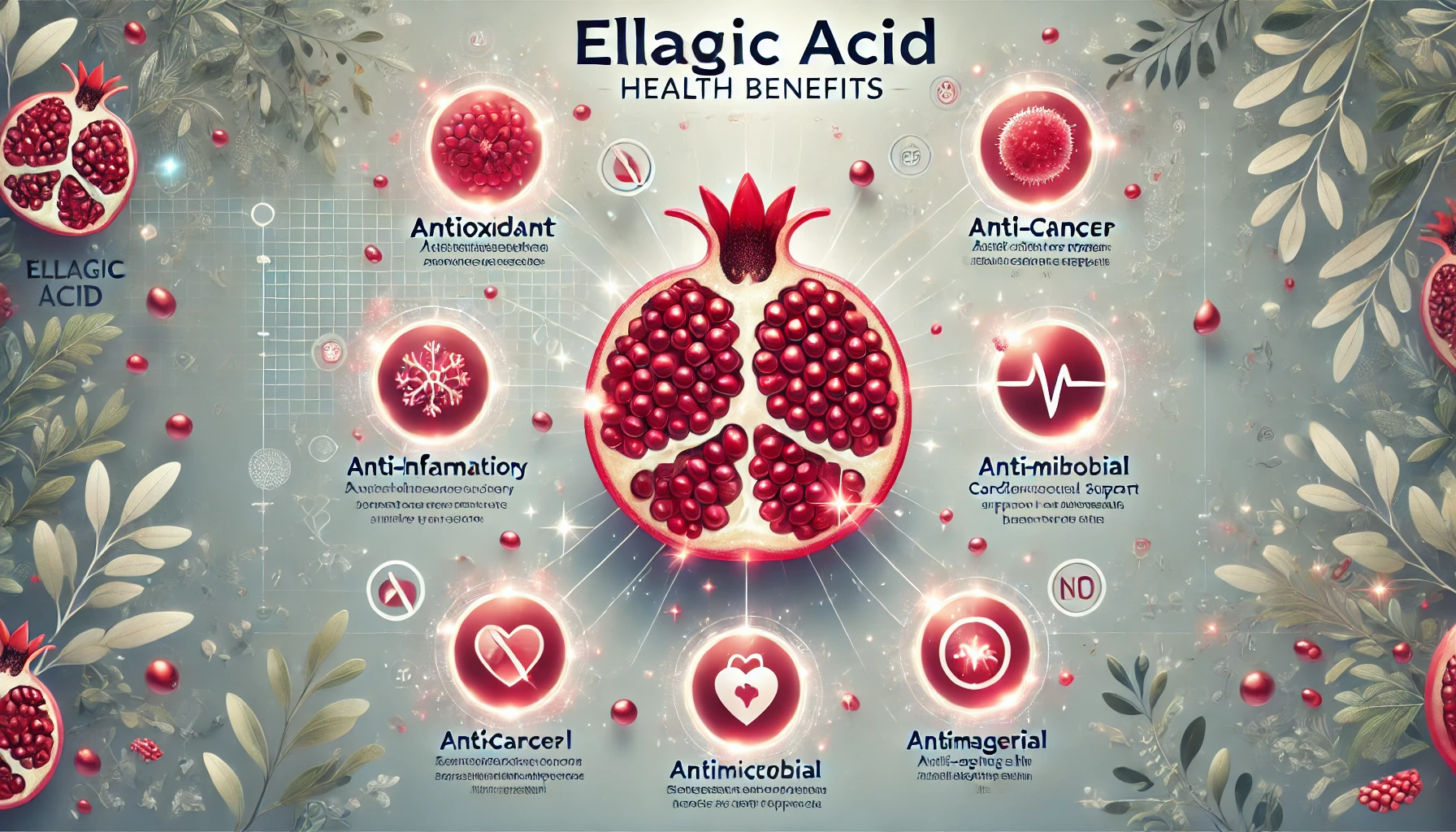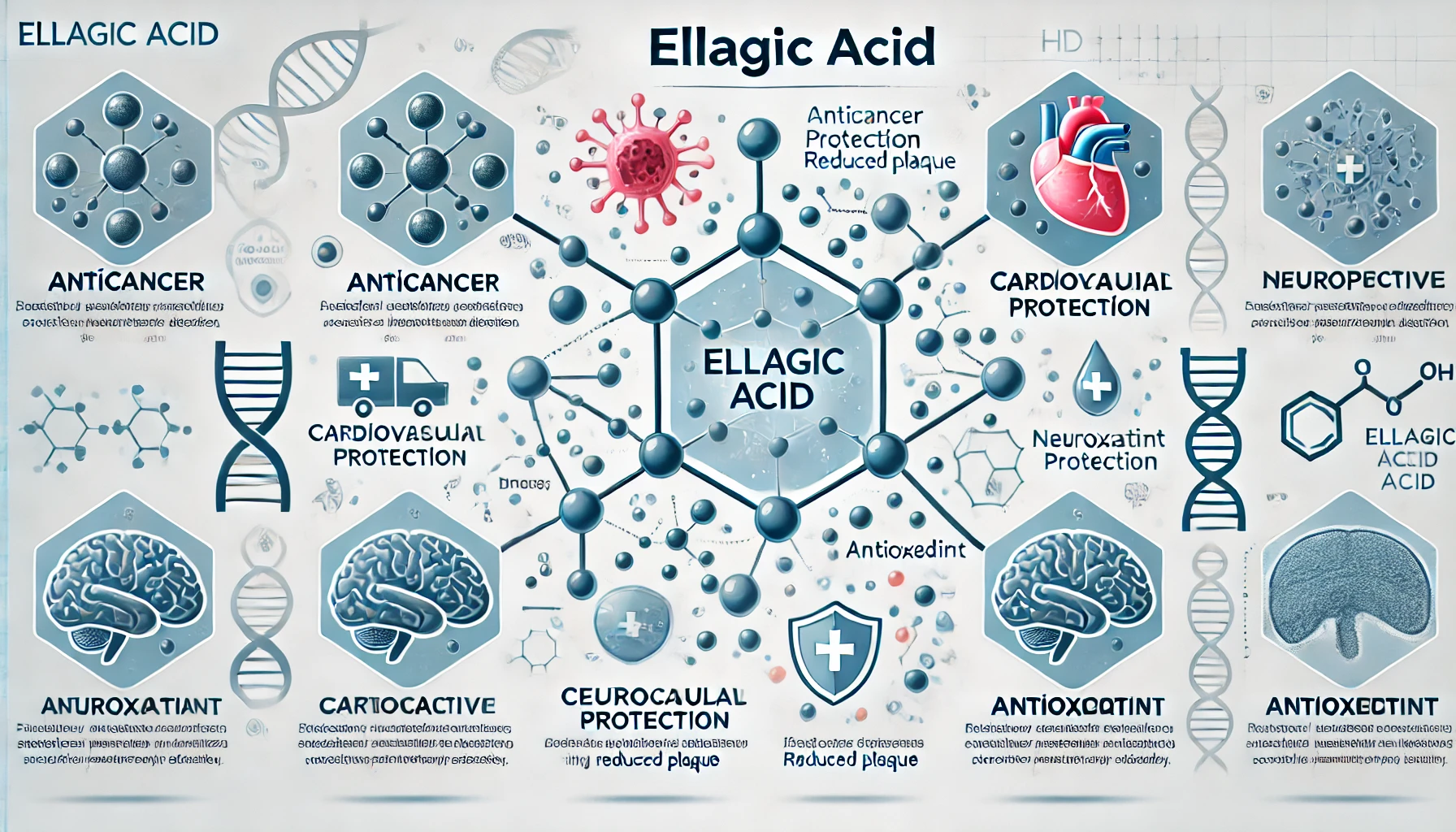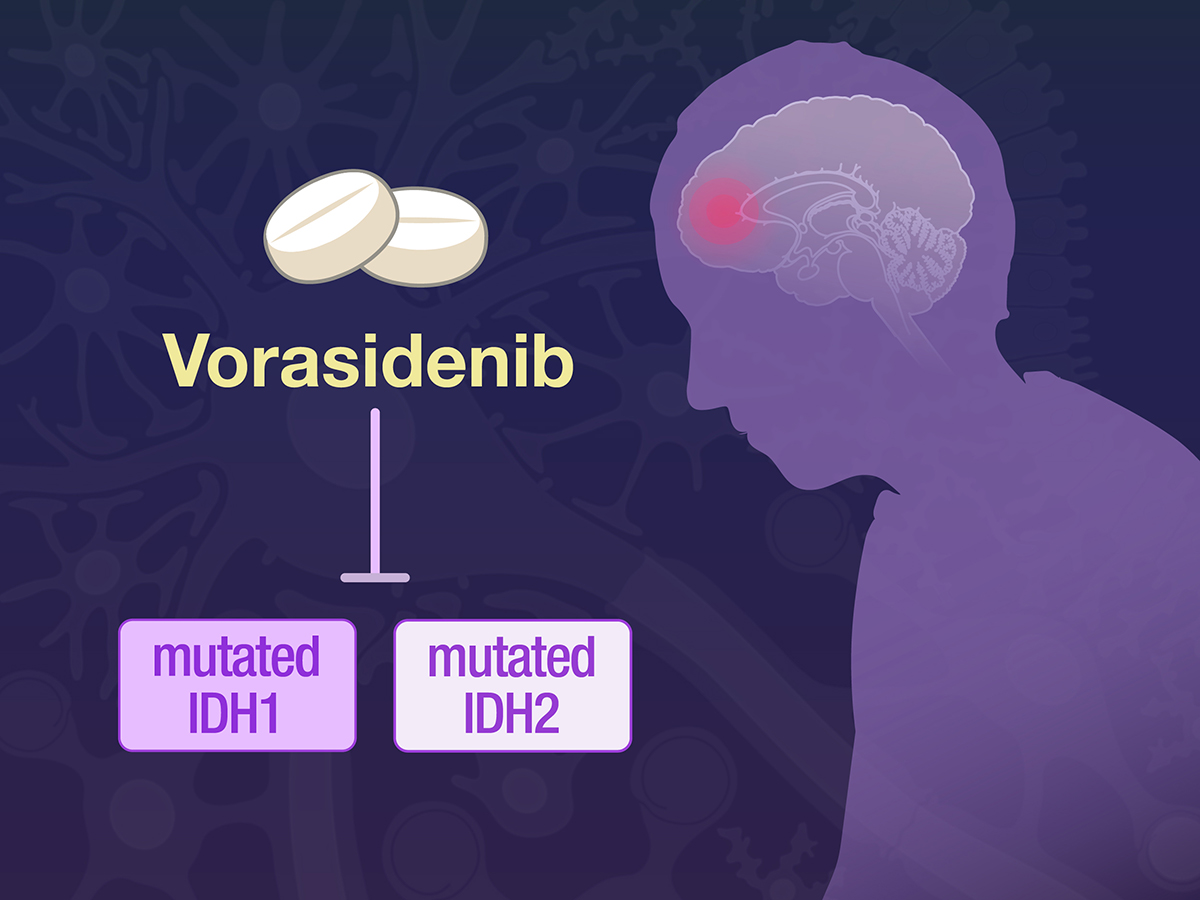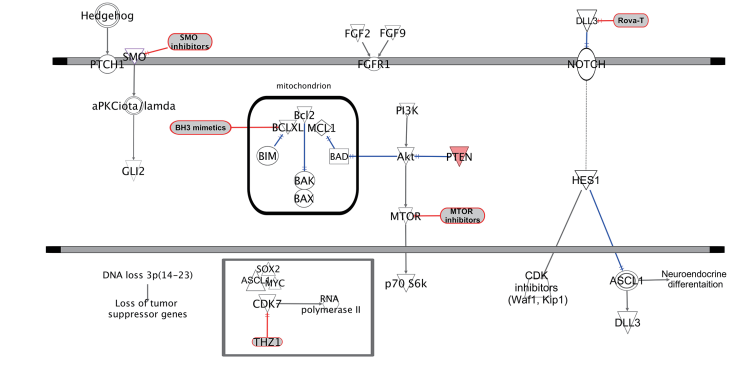Ellagic Acid Benefits: Why This Plant Compound Is a Rising Star in Natural Health
Abstract
Ellagic acid is a naturally occurring polyphenol found in berries, pomegranates, and nuts, renowned for its potent antioxidant and anti-inflammatory properties. This blog post explores its biological functions, top health benefits, dietary sources, and the science behind its effects on cancer prevention, heart health, and aging. It also examines the challenges of ellagic acid bioavailability and the growing interest in its microbial metabolites, especially urolithins. While supplements are available, the article emphasizes the value of consuming ellagic acid through whole foods for optimal health. With scientific evidence continuing to grow, ellagic acid stands out as a promising addition to natural wellness and preventive nutrition.
Introduction: What is Ellagic Acid and Why is Everyone Talking About It?
In the ever-expanding world of superfoods and natural health boosters, ellagic acid is emerging as a compound of serious scientific and wellness interest. Found in a wide range of fruits, nuts, and plants—most notably in pomegranates, raspberries, strawberries, and walnuts—ellagic acid is a natural polyphenol known for its potent antioxidant and anti-inflammatory properties.
But ellagic acid isn’t just a trendy name on supplement bottles; it’s backed by a growing body of research pointing to its potential in protecting the body against chronic diseases, including certain cancers, heart disease, neurodegenerative conditions, and microbial infections. Its capacity to neutralize free radicals, reduce oxidative stress, and influence cellular repair mechanisms makes it especially appealing to both scientists and health-conscious consumers alike.
What’s particularly interesting is that ellagic acid doesn’t work alone. In the body, it’s often metabolized by gut bacteria into powerful compounds called urolithins, which may have even stronger biological activity—especially in terms of supporting mitochondrial health and cellular longevity.
As interest in natural health continues to surge, many are turning to ellagic acid for its promise of disease prevention, skin rejuvenation, and healthy aging. Whether through whole foods or supplements, this plant compound is gaining a reputation as one of the most promising bioactives in nutritional science.
In this article, we’ll explore ellagic acid’s benefits, top food sources, how it works in the body, current scientific evidence, and how to safely incorporate it into your daily routine.
What is Ellagic Acid?
Ellagic acid is a naturally occurring polyphenolic compound that belongs to a class of plant secondary metabolites known as hydrolyzable tannins, more specifically ellagitannins. When consumed, ellagitannins are hydrolyzed in the stomach to release ellagic acid, which is then further metabolized by gut bacteria into bioactive urolithins. These transformations play a crucial role in the compound’s health-promoting effects.
Chemically, ellagic acid is a dilactone of hexahydroxydiphenic acid, which spontaneously forms from the breakdown of ellagitannins. It is not synthesized by the human body and must be obtained through diet. The most abundant sources include berries (especially raspberries, strawberries, and blackberries), pomegranates, walnuts, and pecans. Oak-aged wines and certain medicinal plants also contain trace amounts.
What makes ellagic acid particularly interesting is its versatility in biological systems. It’s been studied extensively for its antioxidant, antiviral, antimicrobial, and anticancer properties. However, despite its powerful activity in lab settings, its bioavailability in humans is relatively low, which has prompted interest in its microbial metabolites, primarily urolithin A.
Moreover, ellagic acid is often included in nutraceuticals and functional foods, marketed for its potential to support skin health, detoxification, and even hormonal balance. As a natural compound, its growing presence in both dietary recommendations and clinical research underscores its potential in preventive medicine and integrative health.
Top Health Benefits of Ellagic Acid
Ellagic acid has attracted significant attention in both clinical and functional nutrition research due to its broad health-promoting properties. Here’s a look at some of the top scientifically studied benefits:

1. Potent Antioxidant Effects
Ellagic acid can neutralize free radicals and reduce oxidative stress, a key factor in aging and chronic diseases like cancer, cardiovascular conditions, and neurodegeneration.
2. Anti-Inflammatory Action
Studies show ellagic acid helps inhibit pro-inflammatory cytokines like TNF-α and IL-6. This may aid in reducing systemic inflammation linked to autoimmune diseases, arthritis, and even depression.
3. Anti-Cancer Properties
Preclinical studies suggest ellagic acid can inhibit tumor growth, block carcinogen binding to DNA, and promote apoptosis (programmed cell death) in cancer cells—particularly in prostate, colon, breast, and skin cancers.
4. Cardiovascular Support
By preventing LDL oxidation and improving endothelial function, ellagic acid contributes to heart health and may reduce the risk of atherosclerosis and hypertension.
5. Antimicrobial and Antiviral Properties
It has shown inhibitory effects on various pathogenic bacteria and viruses, making it a potential complementary agent for infection control.
6. Skin Protection & Anti-Aging
Topical and dietary ellagic acid may protect skin from UV-induced damage and inhibit enzymes that degrade collagen, thus promoting a more youthful appearance.
While these benefits are promising, most clinical results are preliminary, and further human trials are necessary to validate long-term effects.
Natural Sources of Ellagic Acid
If you’re looking to increase your intake of ellagic acid naturally, the good news is that it’s widely available in a variety of fruits, nuts, and plant-based foods. The richest sources are berries, particularly raspberries, blackberries, strawberries, and cranberries, which contain high levels of ellagitannins, the precursors to ellagic acid.
Pomegranates are another exceptional source. In fact, pomegranate juice is often highlighted in scientific literature for its high ellagic acid and polyphenol content. Nuts like walnuts and pecans also provide measurable amounts, along with oak-aged red wines and some exotic fruits like guava and muscadine grapes.
Here’s a quick list of ellagic acid-rich foods:
Raspberries: ~1.5–2.0 mg/g
Strawberries
Pomegranate juice: up to 4.5 mg/mL
Walnuts & pecans
Grapes (especially muscadine)
Green tea and some herbs (e.g., eucalyptus)
Consuming these foods regularly not only boosts ellagic acid levels but also supports overall polyphenol intake, which is key to antioxidant defense and inflammation control.
To maximize benefits, try combining these foods in smoothies, salads, or snacks throughout the week.
Ellagic Acid Supplements — Do They Really Work?
While ellagic acid is abundant in certain fruits and nuts, it’s also available in supplement form, often marketed for its antioxidant, anti-aging, and anti-cancer properties. These supplements typically contain pure ellagic acid, pomegranate extract, or standardized ellagitannins from berries.
However, one of the key concerns with ellagic acid supplementation is its low bioavailability. After oral ingestion, ellagic acid is poorly absorbed in the gut, and much of it is excreted before it can exert significant effects. Its true biological activity comes from its transformation into urolithins by specific gut microbes—meaning not everyone will metabolize it the same way.
Some supplements now focus on urolithin A, the primary metabolite linked to improved cellular energy, muscle function, and longevity, rather than ellagic acid itself. These forms tend to offer better absorption and more consistent effects.
Scientific Evidence – What Does Research Say?
Ellagic acid has been widely studied for its antioxidant, anti-inflammatory, and anticancer properties, primarily in preclinical (lab and animal) models. Numerous studies show it can inhibit tumor growth, protect DNA, and neutralize harmful free radicals. For example, research on prostate and colon cancer cells suggests ellagic acid promotes apoptosis (programmed cell death) and reduces cancer cell proliferation.

In cardiovascular studies, ellagic acid was shown to prevent LDL oxidation and improve vascular function, both of which are essential in preventing atherosclerosis. Its neuroprotective effects are also promising, with studies indicating it may help defend against oxidative stress-related brain damage.
However, while in vitro and animal studies are encouraging, human clinical trials remain limited. The few available human studies often use pomegranate juice or berry extracts, making it difficult to isolate ellagic acid’s exact contribution.
Researchers increasingly point to urolithins, the microbial metabolites of ellagic acid, as key drivers of many health effects observed in humans.
Side Effects & Precautions
Ellagic acid from natural food sources is considered safe for most people, and no major side effects have been reported from typical dietary intake. However, when taken in concentrated supplement form, some individuals may experience mild gastrointestinal upset, such as nausea or bloating.
Another concern is bioavailability variability. Not everyone’s gut microbiota can efficiently convert ellagic acid into urolithins, which are believed to mediate its key health benefits. This means individual results from supplementation may vary significantly.
While ellagic acid appears to be non-toxic, high doses in supplement form haven’t been extensively studied for long-term safety. There’s also a lack of data on its use during pregnancy, breastfeeding, or with certain medications like anticoagulants or chemotherapy agents.
As with any supplement, it’s best to:
Stick to recommended dosages
Consult a healthcare provider, especially if you’re managing a medical condition
Prioritize whole-food sources over isolated compounds when possible
Conclusion: Is Ellagic Acid Worth Adding to Your Health Routine?
Ellagic acid is more than just another trending wellness compound—it’s a powerful plant-based polyphenol with a growing body of research behind it. Found naturally in berries, pomegranates, and nuts, it plays a key role in neutralizing free radicals, reducing inflammation, and supporting cellular health. Studies also suggest promising applications in cancer prevention, cardiovascular protection, and skin health, though more robust human trials are needed to confirm these effects.
What makes ellagic acid especially unique is its journey through the body. After ingestion, it’s metabolized by gut microbes into urolithins, which have shown even greater bioactivity—particularly in areas like mitochondrial function, aging, and muscle health. However, individual gut microbiomes vary, so not everyone will metabolize ellagic acid in the same way.
While supplements are available, the best and safest way to increase your ellagic acid intake is through a balanced diet rich in colorful, polyphenol-packed foods like raspberries, pomegranates, and walnuts. These whole foods offer not only ellagic acid, but also a synergy of nutrients and antioxidants that work together for better health outcomes.
Incorporating ellagic acid into your lifestyle can be as simple as adding a handful of berries to your breakfast or enjoying a glass of pure pomegranate juice. Whether you’re seeking anti-aging support, immune strength, or just better overall wellness, ellagic acid is a worthy addition to your nutrition plan.
References
Zhang M, Cui S, Mao B, Zhang Q, Zhao J, Zhang H, Tang X, Chen W. Ellagic acid and intestinal microflora metabolite urolithin A: A review on its sources, metabolic distribution, health benefits, and biotransformation. Crit Rev Food Sci Nutr. 2023;63(24):6900-6922. doi: 10.1080/10408398.2022.2036693. Epub 2022 Feb 10. PMID: 35142569.
https://pubmed.ncbi.nlm.nih.gov/35142569/
Maleki V, Abbaszadeh S, Seyyed Shoura SM, Sohrabnavi A, Sepandi M, Taghdir M. Potential roles of ellagic acid on metabolic variables in diabetes mellitus: A systematic review. Clin Exp Pharmacol Physiol. 2023 Feb;50(2):121-131. doi: 10.1111/1440-1681.13729. Epub 2022 Nov 10. PMID: 36222179.
https://pubmed.ncbi.nlm.nih.gov/36222179/
Ghazaee H, Raouf Sheibani A, Mahdian H, Gholami S, Askari VR, Baradaran Rahimi V. Ellagic acid as potential therapeutic compound for diabetes and its complications: a systematic review from bench to bed. Naunyn Schmiedebergs Arch Pharmacol. 2024 Dec;397(12):9345-9366. doi: 10.1007/s00210-024-03280-8. Epub 2024 Jul 9. PMID: 38980410.
https://pubmed.ncbi.nlm.nih.gov/38980410/
Naraki K, Ghasemzadeh Rahbardar M, Ajiboye BO, Hosseinzadeh H. The effect of ellagic acid on the metabolic syndrome: A review article. Heliyon. 2023 Oct 31;9(11):e21844. doi: 10.1016/j.heliyon.2023.e21844. PMID: 38027887; PMCID: PMC10661066.
https://pubmed.ncbi.nlm.nih.gov/38027887/
Kaczmarek-Szczepańska B, Kleszczyński K, Zasada L, Chmielniak D, Hollerung MB, Dembińska K, Pałubicka K, Steinbrink K, Swiontek Brzezinska M, Grabska-Zielińska S. Hyaluronic Acid/Ellagic Acid as Materials for Potential Medical Application. Int J Mol Sci. 2024 May 28;25(11):5891. doi: 10.3390/ijms25115891. PMID: 38892078; PMCID: PMC11172586.
https://pubmed.ncbi.nlm.nih.gov/38892078/
Park SH, Kang MK, Kim DY, Lim SS, Kang IJ, Kang YH. Ellagic acid, a functional food component, ameliorates functionality of reverse cholesterol transport in murine model of atherosclerosis. Nutr Res Pract. 2024 Apr;18(2):194-209. doi: 10.4162/nrp.2024.18.2.194. Epub 2024 Mar 4. PMID: 38584811; PMCID: PMC10995779.



